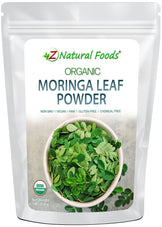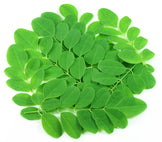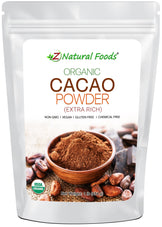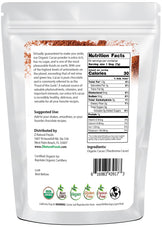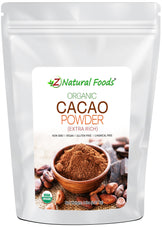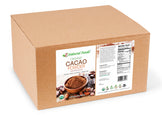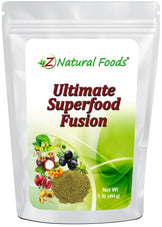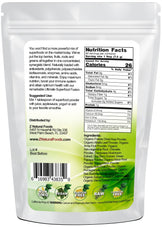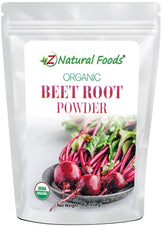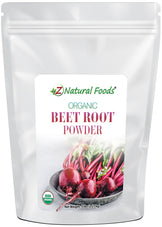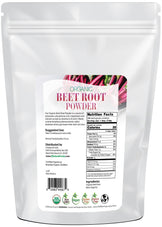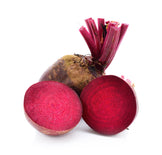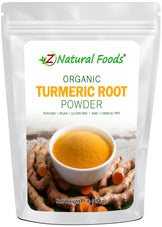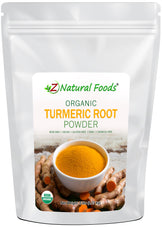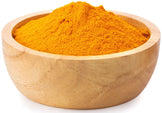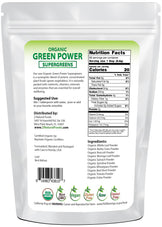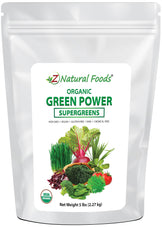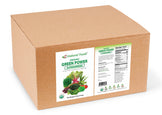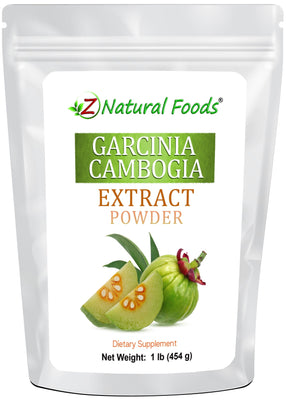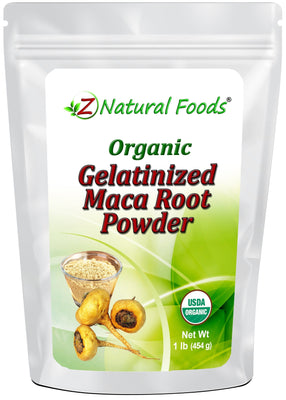About Product
Matcha green tea powder has been used in Japan for hundreds of years. It began as a ceremonial tea used in Zen Buddhist monasteries.
During the 12th century, the practice of whisking matcha powder in hot water was developed and quickly spread to the rest of Japan.
Tea masters began cultivating high-quality matcha powder, and production techniques improved as the demand for it grew.
Today, organic Matcha is cultivated using traditional methods, resulting in a high-quality powder rich in healthy phytonutrients.
The tea is prepared by whisking the powder in hot water until it is frothy, and it is often enjoyed as a hot beverage or used in recipes.
Suggested Use: Add 1/2 tsp (1g) Matcha powder to a little hot water to make a paste. Then add 3-5 oz hot water and whisk with a bamboo or metal whisk until it becomes frothy.
Miscellaneous Facts about our Organic Matcha Green Tea Powder
Certification: Certified USDA Organic.
Botanical Name: Camellia Sinensis.
Other Names: Matcha tea, stone-ground Japanese-style green tea, fine powder tea.
Ingredients: Organic Matcha Green Tea.
Parts Used: Leaf.
Origin: Grown and dried in Japan and packaged with care in Florida, USA.
How to Maintain Optimum Freshness
- This product is packaged in airtight stand-up, resealable foil pouches for optimum freshness.
- Once opened, push the air out of the pouch before resealing it to preserve maximum potency.
- Keep your powder in a cool, dark, dry place.
This product is 100% natural and minimally processed:
Taste, smell, texture, and color vary from batch to batch. Go here to learn why our products may naturally vary.
The important protections we take to bring you safe and nutritious superfoods:
Please go here to discover the essential steps we take to deliver fresh, quality nutrition.
Bulk Quantities?
Need to order a large quantity of our products? We are happy to help! Please get in touch with our Bulk department to discuss the details.
* Product packaging, pictures, and origin may vary.
Sources & References
1. "Matcha - Definition of matcha in English by Oxford Dictionaries". Oxford Dictionaries - English. Retrieved 9 September 2017.
2. Han Wei, "Tang Dynasty Tea Utensils and Tea Culture: Recent Discoveries at Famen Temple," in Chanoyu Quarterly no. 74 (1993)
3. Tsutsui Hiroichi, "Tea-drinking Customs in Japan," paper in Seminar Papers: The 4th International Tea Culture Festival. Korean Tea Culture Association, 1996.
4. "
5. "A Matcha Highlight Part One: Harvesting Grade A Matcha". 1 June 2012. Retrieved 9 September 2017.
6. "How Matcha is Processed". Ippodo Tea. Retrieved 19 September 2012.
7. "How Matcha Green Tea is Produced". www.breakawaymatcha.com. Retrieved 9 September 2017.
8. Kaneko, Shu; Kumazawa, Kenji; Masuda, Hideki; Henze, Andrea; Hofmann, Thomas (March 2006). "Molecular and Sensory Studies on the Umami Taste of Japanese Green Tea". J. Agric. Food Chem. 54 (7): 2688–2694.
9. "Aiya's Blog - The Different Grades of Matcha (and Their Characteristics)". www.aiya-america.com. Retrieved 9 September 2017.
10. "Growing and Processing of Matcha". Marukyu-Koyamaen. Retrieved 18 April 2016.
11. "Preparation of Matcha". Marukyu-Koyamaen.
12. Hosking, Richard (1997). "Wagashi". A Dictionary of Japanese Food. Tuttle Publishing. p. 168.
13. Horaido. "H4". JP: Dion. Archived from the original on 2005-04-06. Matcha used to be sold in packages of 10 monme (ancient measure of about 3.75 g, or 37.5 g for the package) and most tea masters considered that one package provided for 20
14. McKay DL, Blumberg JB. The role of tea in human health: An update. J Am Coll Nutr. 2002;21:1–13.
15. Kavanagh KT, Hafer LJ, Kim DW, Mann KK, Sherr DH, Rogers AE, Sonenshein GE. Green tea extracts decrease carcinogen-induced mammary tumor burden in rats and rate of breast cancer cell proliferation in culture. J Cell Biochem. 2001;82:387–398.
16. Sueoka N, Suganuma M, Sueoka E, Okabe S, Matsuyama S, Imai K, Nakachi K, Fujiki H. A new function of green tea: prevention of lifestyle-related diseases. Ann N Y Acad Sci. 2001;928:274–280. [PubMed]
17. Dona M, Dell'Aica I, Calabrese F, Benelli R, Morini M, Albini A, Garbisa S. Neutrophil restraint by green tea: inhibition of inflammation, associated angiogenesis, and pulmonary fibrosis. J Immunol. 2003;170:4335–4341. [PubMed]
18. Haqqi TM, Anthony DD, Gupta S, Ahmad N, Lee MS, Kumar GK, Mukhtar H. Prevention of collagen-induced arthritis in mice by a polyphenolic fraction from green tea. Proc Natl Acad Sci USA. 1999;96:4524–4529.
19. Sudano Roccaro A, Blanco AR, Giuliano F, Rusciano D, Enea V. Epigallocatechin-gallate enhances the activity of tetracycline in staphylococci by inhibiting its efflux from bacterial cells. Antimicrob Agents Chemother. 2004;48:1968–1973.
20. Sartippour MR, Shao ZM, Heber D, Beatty P, Zhang L, Liu C, Ellis L, Liu W, Go VL, Brooks MN. Green tea inhibits vascular endothelial growth factor (VEGF) induction in human breast cancer cells. J Nutr. 2002;132:2307–2311. [PubMed]
21. Osada K, Takahashi M, Hoshina S, Nakamura M, Nakamura S, Sugano M. Tea catechins inhibit cholesterol oxidation accompanying oxidation of low density lipoprotein in vitro. Comp Biochem Physiol Part C Toxicol Pharmacol. 2001;128:153–164.
22. Weber JM, Ruzindana-Umunyana A, Imbeault L, Sircar S. Inhibition of adenovirus infection and adenain by green tea catechins. Antiviral Res. 2003;58:167–173.
23. Weinreb O, Mandel S, Amit T, Youdim MBH. Neurological mechanisms of green tea polyphenols in Alzheimer's and Parkinson's diseases. J Nutr Biochem. 2004;15:506–516. doi: 10.1016/j.jnutbio.2004.05.002. [PubMed] [Cross Ref]
24. Raederstorff DG, Schlachter MF, Elste V, Weber P. Effect of EGCG on lipid absorption and plasma lipid levels in rats. J Nutr Biochem. 2003;14:326–332. doi: 10.1016/S0955-2863(03)00054-8.[PubMed] [Cross Ref]
25. Naghma K, Hasan M. Tea polyphenols for health promotion. Life Sciences. 2007;81:519–533. doi: 10.1016/j.lfs.2007.06.011. [PMC free article] [PubMed] [Cross Ref]
26. Moyers SB, Kumar NB. Green tea polyphenols and cancer chemoprevention: multiple mechanisms and endpoints for phase II trials. Nutr Rev. 2004;62:204–211. doi: 10.1111/j.1753-4887.2004.tb00041.x. [PubMed] [Cross Ref]
27. Mandel S, Weinreb O, Amit T, Youdim MB. Cell signaling pathways in the neuroprotective actions of the green tea polyphenol(-)-epigallocatechin-3-gallate: implications for neurodegenerative diseases. J Neurochem. 2004;88:1555–1569. [PubMed]
28. Higdon JV, Frei B. Tea catechins and polyphenols: health effects, metabolism, and antioxidant functions. Crit Rev Food Sci Nutr. 2003;43:89–143. doi: 10.1080/10408690390826464. [PubMed][Cross Ref]
29. Xiang YZ, Shang HC, Gao XM, Zhang BL. A comparison of the ancient use of ginseng in traditional Chinese medicine with modern pharmacological experiments and clinical trials. Phytother Res. 2008;22(7):851–858. doi: 10.1002/ptr.2384. [PubMed] [Cross Ref]
30. Cabrera C, Artacho R, Giménez R. Beneficial effects of green tea: a review. J Am Coll Nutr. 2006;25:79–99. [PubMed]
31. Japanese Green Tea Online.com. http://www.japanesegreenteaonline.com
32. Weisburger JH. Approaches for chronic disease prevention based on current understanding of underlying mechanisms. Am J Clin Nutr. 2000;71(6):1710S–1714S. [PubMed]
33. Sato T, Miyata G. The nutraceutical benefit, part I: green tea. Nutrition. 2000;16:315–317. doi: 10.1016/S0899-9007(99)00301-9. [PubMed] [Cross Ref]
34. Belitz DH, Grosch W. Quı'mica de los Alimentos. Zaragoza: Acribia; 1997.
35. Graham HN. Green tea composition, consumption, and polyphenol chemistry. Prev Med. 1992;21:334–350. doi: 10.1016/0091-7435(92)90041-F. [PubMed] [Cross Ref]
36. Vinson JA. Black and green tea and heart disease: a review. Biofactors. 2000;13:127–132. doi: 10.1002/biof.5520130121. [PubMed] [Cross Ref]
37. Sano M, Tabata M, Suzuki M, Degawa M, Miyase T, Maeda-Yamamoto M. Simultaneous determination of twelve tea catechins by high-performance liquid chromatography with electrochemical detection. Analyst. 2001;126:816–820. doi: 10.1039/b102541b. [PubMed][Cross Ref]
38. Khokhar S, Magnusdottir SGM. Total phenol, catechin, and caffeine contents of teas commonly consumed in the United Kingdom. J Agric Food Chem. 2002;50:565–570. doi: 10.1021/jf010153l.[PubMed] [Cross Ref]
39. Fernandez PL, Martin MJ, Gonzalez AG, Pablos F. HPLC determination of catechins and caffeine in tea. Differentiation of green, black and instant teas. Analyst. 2000;125:421–425. doi: 10.1039/a909219f. [PubMed] [Cross Ref]
40. Chen ZY, Zhu QY, Wong YF, Zhang Z, Chung HY. Stabilizing effect of ascorbic acid on green tea catechins. J Agr Food Chem. 1998;46:2512–2516. doi: 10.1021/jf971022g. [Cross Ref]
41. Chen ZY, Zhu QY, Tsang D, Huang Y. Degradation of green tea catechins in tea drinks. J Agr Food Chem. 2001;49:477–482. doi: 10.1021/jf000877h. [PubMed] [Cross Ref]
42. Vanessa C, Gary W. A Review of the Health Effects of Green Tea Catechins in In Vivo Animal Models. J Nutr. 2004;134:3431S–3440S. [PubMed]
43. Roomi MW, Ivanov V, Kalinovsky T, Niedzwiecki A, RathIn M. In vitro and in vivo antitumorigenic activity of a mixture of lysine, proline, ascorbic acid, and green tea extract on human breast cancer lines MDA-MB-231 and MCF-7. Medical Oncol. 2007;22(2):129–138. doi: 10.1385/MO:22:2:129.[PubMed] [Cross Ref]
44. Babu PV, Sabitha KE, Shyamaladevi CS. Therapeutic effect of green tea extract on oxidative stress in aorta and heart of streptozotocin diabetic rats. Chem Biol Interact. 2006;162:114–120. doi: 10.1016/j.cbi.2006.04.009. [PubMed] [Cross Ref]
45. Unno K, Takabayashi F, Yoshida H, Choba D, Fukutomi R, Kikunaga N, Kishido T, Oku N, Hoshino M. Daily consumption of green tea catechin delays memory regression in aged mice. Biogerontology. 2007;8(2):89–95. doi: 10.1007/s10522-006-9036-8. [PubMed] [Cross Ref]
46. Koo MWL, Cho CH. Pharmacological effects of green tea on the gastrointestinal system. Eur J Pharmacol. 2004;500:177–185. doi: 10.1016/j.ejphar.2004.07.023. [PubMed] [Cross Ref]
47. Zaveri NT. Green tea and its polyphenolic catechins: medicinal uses in cancer and noncancer applications. Life Sci. 2006;78:2073–2080. doi: 10.1016/j.lfs.2005.12.006. [PubMed] [Cross Ref]
48. Tsuneki H, Ishizuka M, Terasawa M, Wu JB, Sasaoka T, Kimura I. Effect of green tea on blood glucose levels and serum proteomic patterns in diabetic (db/db) mice and on glucose metabolism in healthy humans. BMC Pharmacol. 2004;4:18–21. doi: 10.1186/1471-2210-4-18. [PMC free article][PubMed] [Cross Ref]
49. Meydani M. Nutrition interventions in aging and age associated disease. Ann N Y Acad Sci. 2001;928:226–235. [PubMed]
50. Mukhtar H, Wang ZY, Katlya SK, Agarwal R. Tea components: antimutagenic and anticarcinogenic effects. Prev Med. 1992;21:351–360. doi: 10.1016/0091-7435(92)90042-G. [PubMed] [Cross Ref]
51. Sano M, Takahashi Y, Yoshino K, Shimoi K, Nakamura Y, Tomita I, Oguni I, Konomoto H. Effect of tea (Camellia sinensis L.) on lipid peroxidation in rat liver and kidney: a comparison of green and black tea feeding. Biol Pharm Bull. 1995;18:1006–1008. [PubMed]
52. Hara Y. Nippon Shokuhin Kogyo. Tokyo: Gakkai: Korin; 1990. Advances in Food Science and Technology.
53. Shim JS, Kang MH, Kim YH, Roh JK, Roberts C, Lee IP. Chemopreventive effect of green tea (Camellia sinensis) among cigarette smokers. Cancer Epidemiol Biomarkers. 1995;4:387–391.[PubMed]
54. McKay DL, Blumberg JB. The role of tea in human health: an update. J Am Coll Nutr. 2002;21:1–13. [PubMed]
55. Lu H, Meng X, Li C, Sang S, Patten C, Sheng S, Hong J, Bai N, Winnik B, Ho CT, Yang CS. Glucuronides of tea catechins: enzymology of biosynthesis and biological activities. Drug Metab Dispos. 2003;31:452–461. doi: 10.1124/dmd.31.4.452. [PubMed] [Cross Ref]
56. Wu CH, Lu FH, Chang CS, Chang TC, Wang RH, Chang CJ. Relationship among habitual tea consumption, percent body fat, and body fat distribution. Obes Res. 2003;11:1088–1095. doi: 10.1038/oby.2003.149. [PubMed] [Cross Ref]
57. Takabayashi F, Harada N, Yamada M, Murohisa B, Oguni I. Inhibitory effect of green tea catechins in combination with sucralfate on Helicobacter pylori infection in Mongolian gerbils. J Gastroenterol. 2004;39:61–63. doi: 10.1007/s00535-003-1246-0. [PubMed] [Cross Ref]
58. Yee YK, Koo MWL, Szeto ML. Chinese tea consumption and lower risk of Helicobacter infection. J Gastroenterol Hepatol. 2002;17:552–555. doi: 10.1046/j.1440-1746.2002.02718.x. [PubMed][Cross Ref]
59. Toda M, Okubo S, Ohnishi R, Shimamura T. Antibacterial and bactericidal activities of Japanese green tea. Nippon Saikingaku Zasshi. 1989;44:669–672. [PubMed]
60. Mukoyama A, Ushijima H, Nishimura S, Koike H, Toda M, Hara Y, Shimamura T. Inhibition of rotavirus and enterovirus infections by tea extracts. Jpn J Med Sci Biol. 1991;44:181–186. [PubMed]
61. Yama TS, Shaha S, Hamilton-Millera JMT. Microbiological activity of whole and fractionated crude extracts of tea (Camellia sinensis), and of tea components. FEMS Microbiol Lett. 1997;152:169–174. doi: 10.1111/j.1574-6968.1997.tb10424.x. [PubMed] [Cross Ref]
62. Hirasawa M, Takada K. Multiple effects of green tea catechin on the antifungal activity of antimycotics against Candida albicans. J Antimicrob Chemother. 2004;53:225–229. doi: 10.1093/jac/dkh046. [PubMed] [Cross Ref]
63. Muraki S, Yamamoto S, Ishibashi H, Horiuchi T, Hosoi T, Suzuki T, Orimo H, Nakamura K. Green tea drinking is associated with increased bone mineral density. J Bone Miner Res. 2003;18:S241.
64. Park H, Ko S, Kim J, Kim S. Effects of green tea extracts and polyphenols on the proliferation and activity of bone cells. J Bone Miner Res. 2003;18:S342.
65. Dorchies OM, Wagner S, Waldhauser KM, Buetler TM, Ruegg UT. Anti-fibrotic properties of green tea catechins on mouse muscle cell cultures. Neuromuscul Disord. 2003;13:639.
66. Sakata R, Ueno T, Nakamura T, Sakamoto M, Torimura T, Sata M. Green tea polyphenols epigallocatechin-3-gallate inhibits platelet-derived growth factor-induced proliferation of human hepatic stellate cell line LI90. J Hepatol. 2004;40:52–59. doi: 10.1016/S0168-8278(03)00477-X.[PubMed] [Cross Ref]
67. Pan TH, Jankovic J, Le WD. Potential therapeutic properties of green tea polyphenols in Parkinson's disease. Drugs Aging. 2003;20:711–721. doi: 10.2165/00002512-200320100-00001. [PubMed][Cross Ref]
68. Sagesaka-Mitane Y, Miwa M, Okada S. Platelet aggregation inhibitors in middle aged Japanese men and women. Ann Epidemiol. 1998;7:280–284.
69. Dvorakova K, Dorr RT, Valcic S, Timmermann B, Alberts DS. Pharmacokinetics of the green tea derivative, EGCG, by the topical route of administration in mouse and human skin. Cancer Chemother Pharmacol. 1999;43:331–335. doi: 10.1007/s002800050903. [PubMed] [Cross Ref]
70. Ishizuk H, Eguchi H, Oda T, Ogawa S, Nakagawa K, Honjo S, Kono S. Relation of coffee, green tea, and caffeine intake to gallstone disease in middle-age Japanese men. Eur J Epidemiol. 2003;18:401–405. doi: 10.1023/A:1024237927985. [PubMed] [Cross Ref]
71. Gupta SK, Halder N, Srivastava S, Trivedi D, Joshi S, Varma SD. Green tea (Camellia sinensis) protects against selenite-induced oxidative stress in experimental cataractogenesis. Ophthalmic Res. 2002;34:258–263. doi: 10.1159/000063881. [PubMed] [Cross Ref]
72. Skrzydlewska E, Ostrowska J, Stankiewicz A, Farbiszewski R. Green tea as a potent antioxidant in alcohol intoxication. Addict Biol. 2002;7:307–314. doi: 10.1080/13556210220139523. [PubMed][Cross Ref]
73. Ferrari CKB, Torres EAFS. Biochemical pharmacology of functional foods and prevention of chronic diseases of aging. Biomed Pharmacother. 2003;57:251–260. doi: 10.1016/S0753-3322(03)00032-5. [PubMed] [Cross Ref]
74. Arburjai T, Natsheh FM. Plants used in cosmetics. Phytother Res. 2003;17:987–1000. doi: 10.1002/ptr.1363. [PubMed] [Cross Ref]
75. Min Zhang C, D'Arcy JH, Jiang-ping H, Xing X. Green tea and the prevention of breast cancer: a case-control study in Southeast China. Carcinogenesis. 2005;28(5):1074–1078. doi: 10.1093/carcin/bgl252. [PubMed] [Cross Ref]
76. Zhang M, Holman CDAJ, Huang JP, Xie X. Green tea and the prevention of breast cancer: a case-control study in southeast China. Carcinogenesis. 2008;29(8):1594–1600. doi: 10.1093/carcin/bgn129. [Cross Ref]
77. Hsu SP, Wu MS, Yang CC, Huang KC, Liou SY, Hsu SM, Chien CT. Chronic green tea extract supplementation reduces hemodialysis-enhanced production of hydrogen peroxide and hypochlorous acid, atherosclerotic factors, and proinflammatory cytokines. Am J Clin Nutr. 2007;86(5):1539–1547. [PubMed]
78. Samman S, Sandstrom B, Toft MB, Bukhave K, Jensen M, Sorensen SS, Hansen M. Green tea or rosemary extract added to foods reduces nonheme-iron absorption. Am J Clin Nutr. 2001;73:607–612. [PubMed]
79. Nelson M, Poulter J. Impact of tea drinking on iron status in the UK: a review. J Hum Nutr Diet. 2004;17:43–54. doi: 10.1046/j.1365-277X.2003.00497.x. [PubMed] [Cross Ref]
80. Deng Z, Tao B, Li X, He J, Chen Y. Effect of green tea and black tea on the metabolisms of mineral elements in old rats. Biol Trace Elem Res. 1998;65:75–86. doi: 10.1007/BF02784115. [PubMed][Cross Ref]
81. Record IR, McInerney JK, Dreosti IE. Black tea, green tea, and tea polyphenols: effects on trace element status in weanling rats. Biol Trace Elem Res. 1996;53:27–43. doi: 10.1007/BF02784542.[PubMed] [Cross Ref]
82. Mira L, Fernandez MT, Santos M, Rocha R, Florencio MH, Jennings KR. Interactions of flavonoids with iron and copper ions: a mechanism for their antioxidant activity. Free Radic Res. 2002;36:1199–1208. doi: 10.1080/1071576021000016463. [PubMed] [Cross Ref]
83. Maliakal PP, Coville PF, Wanwimolruk S. Tea consumption modulates hepatic drug metabolizing enzymes in Wistar rats. J Pharm Pharmacol. 2001;53:569–577. doi: 10.1211/0022357011775695.[PubMed] [Cross Ref]
84. Sohn OS, Surace A, Fiala ES, Richie JP Jr, Colosimo S, Zang E, Weisburger JH. Effects of green and black tea on hepatic xenobiotic metabolizing systems in the male F344 rat. Xenobiotica. 1994;24:119–127. doi: 10.3109/00498259409043226. [PubMed] [Cross Ref]
85. Donovan JL, Crespy V, Manach C, Morand C, Besson C, Scalbert A, Remesy C. Catechin is metabolized by both the small intestine and liver of rats. J Nutr. 2001;131:1753–1757. [PubMed]
86. Okushio K, Suzuki M, Matsumoto N, Nanjo F, Hara Y. Methylation of tea catechins by rat liver homogenates. Biosci Biotechnol Biochem. 1999;63:430–432. doi: 10.1271/bbb.63.430. [PubMed][Cross Ref]
87. Embola CW, Weisburger JH, Weisburger MC. Urinary excretion of N-OH-2-amino-3-methylimidazo [4,5-f]quinoline-N-glucuronide in F344 rats is enhanced by green tea. Carcinogenesis. 2001;22:1095–1098. doi: 10.1093/carcin/22.7.1095. [PubMed] [Cross Ref]
88. Halliwell B, Gutteridge JMC. Free Radicals in Biology and Medicine. Oxford: Clarendon Press; 1985.
89. Abdel-Raheim MAM, Enas AH, Khaled AE. Effect of green tea extract and vitamin c on oxidant or antioxidant. Indian J Clin Biochem. 2009;24(3):280–287. doi: 10.1007/s12291-009-0053-7.[PMC free article] [PubMed] [Cross Ref]
90. Yokozawa T, Nakagawa T, Kitani K. Antioxidative activity of green tea polyphenol in cholesterol-fed rats. J Agric Food Chem. 2002;50:3549–3552. doi: 10.1021/jf020029h. [PubMed] [Cross Ref]
91. Skrzydlewska E, Ostrowska J, Farbiszewski R, Michalak K. Protective effect of green tea against lipid peroxidation in the rat liver, blood serum and the brain. Phytomedicine. 2002;9:232–238. doi: 10.1078/0944-7113-00119. [PubMed] [Cross Ref]
92. Negishi H, Xu JW, Ikeda K, Njelekela M, Nara Y, Yamori Y. Black and green tea polyphenols attenuate blood pressure increases in stroke-prone spontaneously hypertensive rats. J Nutr. 2004;134:38–42. [PubMed]
93. Yokozawa T, Nakagawa T, Lee KI, Cho EJ, Terasawa K, Takeuchi S. Effects of green tea tannin on cisplatin-induced nephropathy in LLC-PK1 cells and rats. J Pharm Pharmacol. 1999;51:1325–1331. doi: 10.1211/0022357991776912. [PubMed] [Cross Ref]
94. Tijburg LBM, Wiseman SA, Meijer GW, Weststrate JA. Effects of green tea, black tea and dietary lipophilic antioxidants on LDL oxidizability and atherosclerosis in hypercholesterolaemic rabbits. Atherosclerosis. 1997;135:37–47. doi: 10.1016/S0021-9150(97)00139-1. [PubMed] [Cross Ref]
95. Alessio HM, Hagerman AE, Romanello M, Carando S, Threlkeld MS, Rogers J, Dimitrova Y, Muhammed S, Wiley RL. Consumption of green tea protects rats from exercise-induced oxidative stress in kidney and liver. Nutr Res. 2003;22:1177–1188. doi: 10.1016/S0271-5317(02)00421-9.[Cross Ref]
96. Pilipenko VI, Shakhovskaia AK, Mal'tsev GIU, Isakov VA. Influence of tableted green tea on index the antioxidant status patients with disease digestion organs. Vopr Pitan. 2008;77(4):58–62.[PubMed]
97. Del Prato S, Piero M, Riccardo CB. Phasic Insulin Release and Metabolic Regulation in Type 2 Diabetes. Diabetes. 2007;51:S109. doi: 10.2337/diabetes.51.2007.S109. [PubMed] [Cross Ref]
98. Sabu MC, Smitha K, Kuttan R. Anti-diabetic activity of green tea polyphenols and their role in reducing oxidative stress in experimental diabetes. J Ethnopharmacol. 2002;83:109–116. doi: 10.1016/S0378-8741(02)00217-9. [PubMed] [Cross Ref]
99. Wu LY, Juan CC, Ho LT, Hsu YP, Hwang LS. Effect of green tea supplementation on insulin sensitivity in Sprague-Dawley rats. J Agric Food Chem. 2004;52:643–648. doi: 10.1021/jf030365d.[PubMed] [Cross Ref]
100. Hasegawa N, Yamda N, Mori M. Powdered green tea has antilipogenic effect on Zucker rats fed a high-fat diet. Phytother Res. 2003;17:477–480. doi: 10.1002/ptr.1177. [PubMed] [Cross Ref]
101. Yang MH, Wang CH, Chen HL. Green, Oolong and black tea extracts modulate lipid metabolism in hyperlipidemia rats fed high-sucrose diet. J Nutr Biochem. 2001;12:14–20. doi: 10.1016/S0955-2863(00)00140-6. [PubMed] [Cross Ref]
102. Iso H, Date C, Wakai K, Fukui M, Tamakoshi A. The relationship between green tea and total caffeine intake and risk for self-reported type 2 diabetes among Japanese adults. Ann Intern Med. 2006;144:554–562. [PubMed]
103. Wolfram S, Raederstorff D, Preller M, Wang Y, Teixeira SR, Riegger C, Weber P. Epigallocatechin gallate supplementation alleviates diabetes in rodents. J Nutr. 2006;136:3512–3518. [PubMed]
104. Waltner-Law ME, Wang XL, Law BK, Hall RK, Nawano M, Granner DK. Epigallocatecin gallate, a constituent of green tea, represses hepatic glucose production. J Biol Chem. 2002;277:34933–34940. doi: 10.1074/jbc.M204672200. [PubMed] [Cross Ref]
105. Anderson RA, Polansky MM. Tea enhances insulin activity. J Agric Food Chem. 2002;50:7182–7186. doi: 10.1021/jf020514c. [PubMed] [Cross Ref]
106. Gomes A, Vedasiromoni JR, Das M, Sharma RM, Ganguly DK. Anti-hyperglycemic effect of black tea (Camellia sinensis) in rat. J Ethnopharmacol. 1995;45:223–226. doi: 10.1016/0378-8741(95)01223-Z. [PubMed] [Cross Ref]
107. Kobayashi Y, Suzuki M, Satsu H, Arai S, Hara Y, Suzuki K, Miyamoto Y, Shimizu M. Green tea polyphenols inhibit the sodium-dependent glucose transporter of intestinal epithelial cells by a competitive mechanism. J Agric Food Chem. 2000;48:5618–5623. doi: 10.1021/jf0006832.[PubMed] [Cross Ref]
108. Yang JA, Choi JH, Rhee SJ. Effects of green tea catechin on phospholipase A2 activity and antithrombus in streptozotocin diabetes rats. J Nutr Sci Vitaminol (Tokyo) 1999;45:337–346.[PubMed]
109. Choi JH, Cha BK, Rhee SJ. Effect of green tea catechin on hepatic microsomal phospholipase A2 activities and changes of hepatic phospholipid species in streptozotocin-induced diabetic rats. J Nutr Sci Vitaminol (Tokyo) 1998;44:673–683. [PubMed]
110. Illing EKB, Gray CH, Lawrence RD. Blood glutathione and non-glucose reducing substances in diabetes. J Biochem. 1951;48:637–640. [PMC free article] [PubMed]
111. Vucic M, Gavell M, Bozikov V, Ashcroft JH, Rocic B. Superoxide dismutase activity in lymphocytes and polymorphonuclear cells of diabetic patients. Eur J Clin Chem Biochem. 1997;35:517–521.[PubMed]
112. Polychronopoulos E, Panagiotakos DB, Polystipioti A. Diet, lifestyle factors and hypercholesterolemia in elderly men and women from Cyprus. Lipids Health Dis. 2005;4:17–21. doi: 10.1186/1476-511X-4-17. [PMC free article] [PubMed] [Cross Ref]
113. Wu LY, Juan CC, Hwang LS, Hsu YP, Ho PH, Ho LT. Green tea supplementation ameliorates insulin resistance and increases glucose transporter IV content in a fructose-fed rat model. Eur J Nutr. 2004;43:116–124. doi: 10.1007/s00394-004-0450-x. [PubMed] [Cross Ref]
114. Han MK. Epigallocatechin gallate, a constituent of green tea, suppresses cytokine-induced pancreatic beta-cell damage. Exp Mol Med. 2003;35:136–139. [PubMed]
115. Song EK, Hur H, Han MK. Epigallocatechin gallate prevents autoimmune diabetes induced by multiple low doses of streptozotocin in mice. Arch Pharm Res. 2003;26:559–563. doi: 10.1007/BF02976881. [PubMed] [Cross Ref]
116. Lambert JD, Lee MJ, Lu H, Meng X, Hong JJJ, Seril DN, Sturgill MG, Yang CS. Epigallocatechin-3-gallate is absorbed but extensively glucuronidated following oral administration to mice. J Nutr. 2003;133:4172–4177. [PubMed]
117. Ullmann U, Haller J, Decourt JP, Girault N, Girault J, Richard-Caudron AS, Pineau B, Weber P. A single ascending dose study of epigallocatechin gallate in healthy volunteers. J Int Med Res. 2003;31:88–101. [PubMed]
118. Kao YH, Chang HH, Lee MJ, Chen CL. Tea, obesity, and diabetes. Mol Nutr Food Res. 2006;50(2):188–210. doi: 10.1002/mnfr.200500109. [PubMed] [Cross Ref]
119. Shoji Y, Nakashima H. Glucose-lowering effect of powder formulation of African black tea extract in KK-A(y)/TaJcl diabetic mouse. Arch Pharmacol Res. 2006;29(9):786–794. doi: 10.1007/BF02974080. [PubMed] [Cross Ref]
120. Rudelle S, Ferruzzi MG, Cristiani I, Moulin J, Mace K, Acheson KJ, Tappy L. Effect of a thermogenic beverage on 24-hour energy metabolism in humans. Obesity. 2007;15(2):349–355. doi: 10.1038/oby.2007.529. [PubMed] [Cross Ref]
121. Lin JK, Lin-Shiau SY. Mechanisms of hypolipidemic and anti-obesity effects of tea and tea polyphenols. Mol Nutr Food Res. 2006;50(2):211–217. doi: 10.1002/mnfr.200500138. [PubMed][Cross Ref]
122. Klaus S, Pultz S, Thone-Reineke C, Wolfram S. Epigallocatechin gallate attenuates diet-induced obesity in mice by decreasing energy absorption and increasing fat oxidation. Int J Obes. 2005;29(6):615–623. doi: 10.1038/sj.ijo.0802926. [PubMed] [Cross Ref]
123. Dulloo AG, Seydoux J, Girardier L, Chantre P, Vandermander J. Green tea and thermogenesis: interactions between catechin-polyphenols, caffeine and sympathetic activity. Int J Obes Relat Metab Disord. 2000;24(2):252–258. doi: 10.1038/sj.ijo.0801101. [PubMed] [Cross Ref]
124. Boschmann M, Thielecke F. The effects of epigallocatechin-3-gallate on thermogenesis and fat oxidation in obese men: a pilot study. J Am Coll Nutr. 2007;26(4):389S–395S. [PubMed]
125. Schmidt M, Schmitz HJ, Baumgart A, Guedon D, Netsch MI, Kreuter MH, Schmidlin CB, Schrenk D. Toxicity of green tea extracts and their constituents in rat hepatocytes in primary culture. Food Chem Toxicol. 2005;43:307–314. doi: 10.1016/j.fct.2004.11.001. [PubMed] [Cross Ref]
126. Takabayashi F, Tahara S, Kanerko T, Harada N. Effect of green tea catechins on oxidative DNA damage of hamster pancreas and liver induced by N-nitrosobis (2-oxopropyl) amine and/or oxidized soybean oil. Biofactors. 2004;21:335–337. doi: 10.1002/biof.552210165. [PubMed] [Cross Ref]
127. Yun SY, Kim SP, Song DK. Effects of (-)-epigallocatechin-3-gallate on pancreatic beta-cell damage in streptozotocin-induced diabetic rats. Eur J Pharmacol. 2006;541:115–121. doi: 10.1016/j.ejphar.2006.04.040. [PubMed] [Cross Ref]
128. Sakamoto Y, Mikuriya H, Tayama K, Takahashi H, Nagasawa A, Yano N, Yuzawa K, Ogata A, Aoki N. Goitrogenic effects of green tea extract catechins by dietary administration in rats. Arch Toxicol. 2001;75:591–596. doi: 10.1007/s00204-001-0286-6. [PubMed] [Cross Ref]
129. Satoh K, Sakamoto Y, Ogata A, Nagai F, Mikuriya H, Numazawa M, Yamada K, Aoki N. Inhibition of aromatase activity by green tea extract catechins and their endocrinological effects of oral administration in rats. Food Chem Toxicol. 2002;40:925–933. doi: 10.1016/S0278-6915(02)00066-2.[PubMed] [Cross Ref]
130. Bruneton J. Pharmacognosie. Phytochimie. Plantes Me'dicinales. Paris: Technique Documentation-Lavoisier; 2001.
131. Costa LM, Gouveia ST, Nobrega JA. Comparison of heating extraction procedures for Al, Ca, Mg and Mn in tea samples. Ann Sci. 2002;18:313–318. doi: 10.2116/analsci.18.313. [PubMed][Cross Ref]
132. Hamdaoui MH, Chabchob S, Heidhili A. Iron bioavailability and weight gains to iron-deficient rats fed a commonly consumed Tunisian meal "bean seeds ragout" with or without beef and with green or black tea decoction. J Trace Elem Med Biol. 2003;17:159–164. doi: 10.1016/S0946-672X(03)80020-2. [PubMed] [Cross Ref]
133. Ahmad N et al. Cutaneous photochemoprotection by Green Tea: A brief review. Skin Pharmacol App`l Skin Physiol 2001; 14: 69-76. (ref. 4865)
134. Katiyar SK, et al. Green Tea and skin photoprotection. Cosmetics Toiletries 2001; 116 9: 69- 76. (ref. 4760)
135. Craig A, et al. Cutaneous photoprotection from ultraviolet injury by green tea polyphenols. Journal American Academy of Dermatology 2001; 44 3: 425-432. (ref. 4866)
136. Säntosh K, et al. Green tea polyphenolic antioxidants and skin photoprotection (Review).International Journal of Oncology 2001; 18:1307-1313. (ref. 4833)
137. Morganti, P, et al. New data on skin photoprotection. International Journal of Cosmetic Sciente 2000; 22 4: 305-312. (ref. 3969)
138. Säntosh K, et al. Green tea and skin. Arch Dermatol 2000; 136 8: 989-994. (ref.4867) Säntosh K, et al. Polyphenolic antioxidant Epigallocatechin-3-Gallate from Green Tea reduces UVB-induced inflammatory responses and infiltration of leukocytes in human skin. Photchemistry and Phochemistry 1999; 69 2: 148-153. (ref. 4868)
139. Guo Q, et al. Studies on protective mechanisms of four components of green tea polyphenols against lipid peroxidation in synaptosomes. Biochimica et Biophysica Acta 1996; 1304: 210-222. (ref. 2532)
140. Fourneau C, et al. Radical scavenging evaluation of green tea extracts. Phytotherapy Research 1996; 10: 529-530. (ref. 2533)
141. Morazzoni P, et al. Phytochemical anti-oxidants for cosmetic application. Agro-Food-Industry Hi-Tech 1995 : 12-16 (ref. 1996)
142. Czygan FC, et al. Herbal Drugs and phytopharmaceuticals. London :Norman Grainger Bisset, 1994; 490-492
143. Makimura M et al. Inhibitory Effect of Tea Catechins on Collagenase Activity. J Periodontol 1993; 64 7: 630-636. (ref. 1848)
144. Lunder TL. Catechins of Green Tea. Antioxidant Activity. ACS Sumposium series 1992; 507: 114-120. (ref. 1843)
145. Weisburger JH. Physiological and Pharmacological Effects of Camelia sinensis (Tea): First International Symposium. Preventive Medicine 1992; 21: 329-330. (ref. 1846)
146. Ho CT et al. Antioxidative Effect of Polyphenol Extract Prepared from Various Chinese Teas. Preventive medicine 1992; 21: 520-525. (ref. 1847)
147. Finger A et al. Chromatography of tea constituents. Journal of Chromatography 1992; 624: 293-315. (ref. 1827)
148. Wang ZY, et al. Inhibitory effect of green tea on the growth of established skin papillomas in mice Cancer Res 1992; 52 23: 6657-6665
149. Tofovic S, et al. Caffeine Potentiates Vasodilator-Induced Renin Release. The Journal of Pharmacology and Experimental Therapeutics1991; 256 3: 850 - 860. (ref. 187)
150. March 2013, Volume 33, Issue 3, Pages 180"“187. "Green tea supplementation increases glutathione and plasma antioxidant capacity in adults with the metabolic syndrome" Authors: Basu A, Betts NM, Mulugeta A, Tong C, Newman E, Lyons TJ.
151. http://www.naturalnews.com/044667_green_tea_cognitive_function_antioxidants.html
152. http://www.eurekalert.org/pub_releases/2014-04/uob-gtb040714.php
153. http://www.naturalnews.com/028600_eye_disease_green_tea.html
154. http://science.naturalnews.com/green_tea.html
155. http://www.naturalnews.com/028877_lung_cancer_green_tea.html
156. Bruneton J. Elementos de FitoquÃmica y de Farmacognosia. Zaragoza: Acribia, 1991; 543-550. Farmacopea Francesa IX Edición. DAB 10
157. http://www.greenteahealtheffects.com/chemical-constituents.htm
158. http://www.ncbi.nlm.nih.gov/pubmed/1614995
159. http://umm.edu/health/medical/altmed/herb/green-tea
160. Bruneton J. Elementos de FitoquÃmica y de Farmacognosia. Zaragoza: Acribia, 1991; 543-550. Farmacopea Francesa IX Edición. DAB 10
161. https://articles.mercola.com/sites/articles/archive/2018/06/18/green-tea-boosts-heart-brain-health.aspx
162. https://www.cambridge.org/core/journals/british-journal-of-nutrition/article/effects-of-tea-intake-on-blood-pressure-a-metaanalysis-of-randomised-controlled-trials/AD10B8AF38E3184FCFDDC9778F833835
163. http://time.com/3517842/this-kind-of-tea-lowers-blood-pressure-naturally/#3517842/this-kind-of-tea-lowers-blood-pressure-naturally/
164. http://content.time.com/time/health/article/0,8599,1820250,00.html
165. https://www.ncbi.nlm.nih.gov/pubmed/16855537
166. http://www.jbc.org/content/early/2018/05/31/jbc.RA118.002038.abstract
167. https://www.ncbi.nlm.nih.gov/pmc/articles/PMC5477123/
168. https://newatlas.com/green-tea-heart-disease-prevention/54885/
169. https://www.ncbi.nlm.nih.gov/pubmed/20089791
170. https://www.eurekalert.org/pub_releases/2004-12/aafc-gtp112904.php
171. https://www.ncbi.nlm.nih.gov/pubmed/21827739
172. https://www.ncbi.nlm.nih.gov/pubmed?term=Epigallocatechin-3-gallate+and+postprandial+fat+oxidation+in+overweight/obese+male+volunteers&TransSchema=title&cmd=detailssearch
173. https://www.ncbi.nlm.nih.gov/pubmed?orig_db=PubMed&cmd=Search&TransSchema=title&term=%22European+journal+of+clinical+nutrition%22%5BJour%5D+AND+2008%5Bpdat%5D+AND+tea
174. https://www.ncbi.nlm.nih.gov/pubmed?term=%22Journal+of+agricultural+and+food+chemistry%22%5BJour%5D+AND+Green+Tea+Catechins+and+Their+Oxidative+Protection+in+the+Rat+Eye&TransSchema=title&cmd=detailssearch
175. https://www.ncbi.nlm.nih.gov/pubmed/18515521?ordinalpos=23&itool=EntrezSystem2.PEntrez.Pubmed.Pubmed_ResultsPanel.Pubmed_RVDocSum
176. https://www.ncbi.nlm.nih.gov/pubmed/22020144
177. https://www.precisionnutrition.com/rr-green-tea-hazards
178. https://www.sciencedaily.com/releases/2005/01/050128221248.htm
179. https://www.globalhealingcenter.com/natural-health/green-tea-benefits/
180. https://www.perio.org/consumer/green-tea
181. https://www.sciencedaily.com/releases/2007/11/071113163016.htm
182. https://www.natural-holistic-health.com/health-benefits-of-matcha-tea-how-to-make-matcha-tea/
183. https://www.news-medical.net/news/2007/04/30/24367.aspx
184. http://www.jneurosci.org/content/25/38/8807?maxtoshow=&HITS=10&hits=10&RESULTFORMAT=&fulltext=green+tea&andorexactfulltext=and&searchid=1127403163954_5553&stored_search=&FIRSTINDEX=0&sortspec=relevance&resourcetype=1&journalcode=jneuro
185. https://www.medicalnewstoday.com/articles/322006.php
* Reviews & Success Stories Disclaimer
Product reviews solely reflect the views and opinions expressed by the contributors and not those of Z Natural Foods. Z Natural Foods does not verify or endorse any claims made in these reviews. Statements have not been evaluated by the FDA and are not intended to diagnose, treat, cure, or prevent any disease or health condition.REFERRAL PROGRAM
Share your personal link to your friends and welcome them with rewards. Claim yours when they make their first purchase.

GIVE
$10 off discount

GET
$10 off discount








